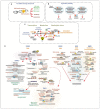Exploiting the DNA Damage Response for Prostate Cancer Therapy
- PMID: 38201511
- PMCID: PMC10777950
- DOI: 10.3390/cancers16010083
Exploiting the DNA Damage Response for Prostate Cancer Therapy
Abstract
Prostate cancers that progress despite androgen deprivation develop into castration-resistant prostate cancer, a fatal disease with few treatment options. In this review, we discuss the current understanding of prostate cancer subtypes and alterations in the DNA damage response (DDR) that can predispose to the development of prostate cancer and affect its progression. We identify barriers to conventional treatments, such as radiotherapy, and discuss the development of new therapies, many of which target the DDR or take advantage of recurring genetic alterations in the DDR. We place this in the context of advances in understanding the genetic variation and immune landscape of CRPC that could help guide their use in future treatment strategies. Finally, we discuss several new and emerging agents that may advance the treatment of lethal disease, highlighting selected clinical trials.
Keywords: ATM; ATR; DNA damage response; DNA-PK; PARP; androgen; hypoxia; immunotherapy; prostate cancer; radiopharmaceutical therapy; radiotherapy.
Conflict of interest statement
The authors declare no conflicts of interest.
Figures




Similar articles
-
A review of treatments targeting DNA-repair gene defects in metastatic castration resistant prostate cancer.Front Oncol. 2023 Mar 14;13:1150777. doi: 10.3389/fonc.2023.1150777. eCollection 2023. Front Oncol. 2023. PMID: 36998466 Free PMC article. Review.
-
ATM Loss Confers Greater Sensitivity to ATR Inhibition Than PARP Inhibition in Prostate Cancer.Cancer Res. 2020 Jun 1;80(11):2094-2100. doi: 10.1158/0008-5472.CAN-19-3126. Epub 2020 Mar 3. Cancer Res. 2020. PMID: 32127357 Free PMC article.
-
Talazoparib monotherapy in metastatic castration-resistant prostate cancer with DNA repair alterations (TALAPRO-1): an open-label, phase 2 trial.Lancet Oncol. 2021 Sep;22(9):1250-1264. doi: 10.1016/S1470-2045(21)00376-4. Epub 2021 Aug 10. Lancet Oncol. 2021. PMID: 34388386 Clinical Trial.
-
Castration-Resistant Prostate Cancer: From Uncovered Resistance Mechanisms to Current Treatments.Cancers (Basel). 2023 Oct 19;15(20):5047. doi: 10.3390/cancers15205047. Cancers (Basel). 2023. PMID: 37894414 Free PMC article. Review.
-
Targeting DNA Damage Response in Prostate and Breast Cancer.Int J Mol Sci. 2020 Nov 4;21(21):8273. doi: 10.3390/ijms21218273. Int J Mol Sci. 2020. PMID: 33158305 Free PMC article. Review.
Cited by
-
Precision Medicine in Castration-Resistant Prostate Cancer: Advances, Challenges, and the Landscape of PARPi Therapy-A Narrative Review.Int J Mol Sci. 2024 Feb 11;25(4):2184. doi: 10.3390/ijms25042184. Int J Mol Sci. 2024. PMID: 38396858 Free PMC article. Review.
-
UK-based clinical testing programme for somatic and germline BRCA1/2, ATM and CDK12 mutations in prostate cancer: first results.BMJ Oncol. 2025 Feb 24;4(1):e000592. doi: 10.1136/bmjonc-2024-000592. eCollection 2025. BMJ Oncol. 2025. PMID: 40046829 Free PMC article.
-
TLK1>Nek1 Axis Promotes Nuclear Retention and Activation of YAP with Implications for Castration-Resistant Prostate Cancer.Cancers (Basel). 2024 Aug 22;16(16):2918. doi: 10.3390/cancers16162918. Cancers (Basel). 2024. PMID: 39199688 Free PMC article.
References
-
- Mohler J.L., Antonarakis E.S., Armstrong A.J., D’Amico A.V., Davis B.J., Dorff T., Eastham J.A., Enke C.A., Farrington T.A., Higano C.S., et al. Prostate Cancer, Version 2.2019, NCCN Clinical Practice Guidelines in Oncology. J. Natl. Compr. Cancer Netw. 2019;17:479–505. doi: 10.6004/jnccn.2019.0023. - DOI - PubMed
-
- Lavaud P., Dumont C., Thibault C., Albiges L., Baciarello G., Colomba E., Flippot R., Fuerea A., Loriot Y., Fizazi K. Next-Generation Androgen Receptor Inhibitors in Non-Metastatic Castration-Resistant Prostate Cancer. Ther. Adv. Med. Oncol. 2020;12:1758835920978134. doi: 10.1177/1758835920978134. - DOI - PMC - PubMed
Publication types
Grants and funding
LinkOut - more resources
Full Text Sources
Research Materials
Miscellaneous

